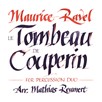
Danse
Composer: Claude Debussy
Instrument: Marimba Duo
Level: Advanced
Published: 2014
Price: €22.00
Item details
-
Description +
-
Adapted and edited by Nancy Zeltsman
Duration: 5 min.Preface
Debussy composed Tarantelle Styrienne for piano in 1890 in his late twenties, and it was published with that title in 1891. (The title may have conflated Italian tarantella with the state of Styria in southeast Austria.) He retitled it Danse when the work was reissued in 1903 with a few revisions. While Danse is one of Debussy’s lesser known pieces, it is however notable that it was composed between his famous piano compositions Rêverie and Suite Bergamasque. After Debussy’s death, Maurice Ravel adapted Danse for orchestra, which received its premiere in 1923.
-
-
Instrumentation +
-
Two Marimbas
-
-
About the composer +
-
Claude-Achille Debussy (22 August 1862 – 25 March 1918) was a French composer. Along with Maurice Ravel, he was one of the most prominent figures associated with Impressionist music, though he himself disliked the term when applied to his compositions. He was made Chevalier of the Legion of Honour in his native France in 1903. Debussy was among the most influential composers of the late 19th and early 20th centuries, and his use of non-traditional scales and chromaticism influenced many composers who followed.
Debussy's music is noted for its sensory content and frequent usage of nontraditional tonalities. The prominent French literary style of his period was known as Symbolism, and this movement directly inspired Debussy both as a composer and as an active cultural participant.
-
-
Reviews +
-
Percussive Notes, November 2016
French composer Claude Debussy was one of the most prominent figures associated with impressionist music in the late 19th century. While this piece for piano (originally titled “Tarantelle Styrienne”) was one of his lesser-known works, it is a wonderful example of his playful nature as a composer. The lively tempo and active rhythmic relationship between the two voices transfer well to marimbas, which coalesce to form a light-hearted duo that lasts just under six minutes.
Throughout this arrangement, both of the marimba parts shoulder the “heavy lifting” in terms of interlocking rhythmic passages, melodic and harmonic complexity, and musical sensitivity. Performers need to be proficient with four-mallet technique at all dynamic levels from triple-piano to fortissimo at a brisk tempo. Block chord presentations (like Musser etudes) mixed with one-handed melodic figures in octaves and multiple one-handed rolls add to the challenges in this arrangement.
The depth of Debussy’s impressionistic beauty and harmonic intricacies are evident in Zeltsman’s adaptation and will challenge experienced marimba players while simultaneously delighting audience members. This professional-level duo is well worth the time and attention it requires for a successful performance.
—Joshua D. Smith
-
-
Credits +
-
Front Cover image: Robert Scott, Circling Hawk Photography (rwalkleyscott.zenfolio.com)
Front Cover design: Ronni Kot Wenzell
Engraving: Johan Svitzer
Printed in Copenhagen, Denmark
www.editionsvitzer.com
-






